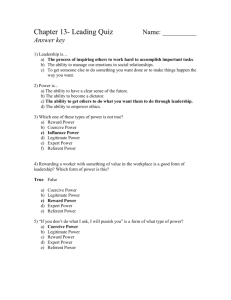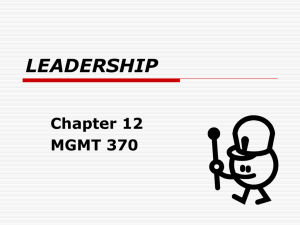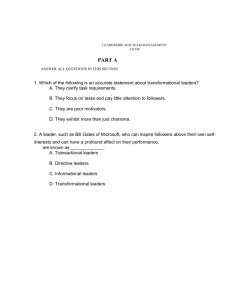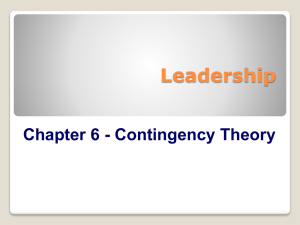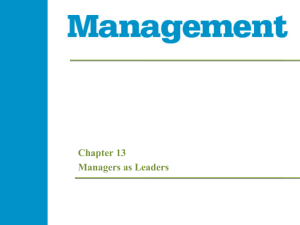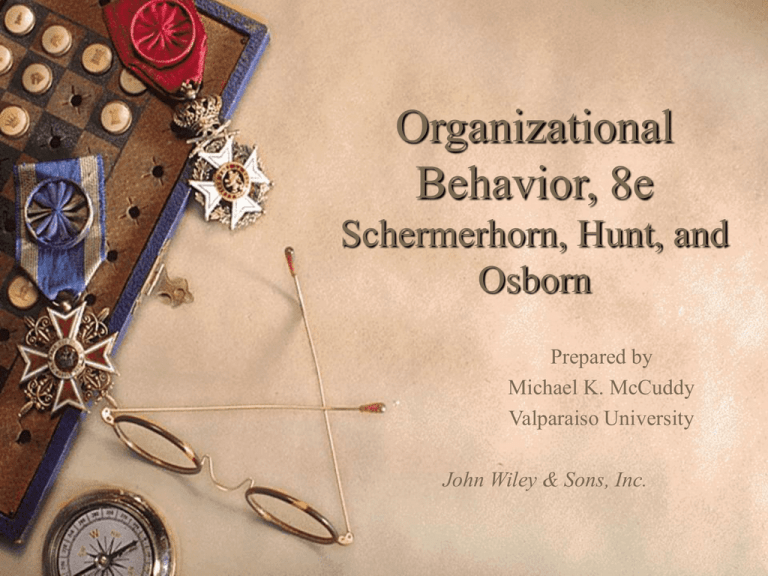
Organizational
Behavior, 8e
Schermerhorn, Hunt, and
Osborn
Prepared by
Michael K. McCuddy
Valparaiso University
John Wiley & Sons, Inc.
COPYRIGHT
Copyright 2003 © John Wiley & Sons, Inc. All rights reserved.
Reproduction or translation of this work beyond that permitted in Section
117 of the 1976 United States Copyright Act without the express written
permission of the copyright owner is unlawful. Request for further
information should be addressed to the Permissions Department, John Wiley
& Sons, Inc. The purchaser may make back-up copies for his/her own use
only and not for distribution or resale. The Publisher assumes no
responsibility for errors, omissions, or damages, caused by the use of these
programs or from the use of the information contained herein.
Organizational Behavior: Chapter 14
2
Chapter 14
High Performance Leadership
Study questions.
– What is leadership, and how does it differ
from management?
– What are the trait and behavioral leadership
perspectives?
– What are the situational or contingency
leadership approaches?
– How does attribution theory relate to
leadership?
Organizational Behavior: Chapter 14
3
Chapter 14
High Performance Leadership
Study questions — cont.
– What are the new leadership perspectives, and
why are they especially important in high
performance organizations?
Organizational Behavior: Chapter 14
4
What is leadership, and how does
it differ from management?
Management promotes stability or enables the
organization to run smoothly.
Leadership promotes adaptive or useful changes.
Persons in managerial positions may be involved
with both management and leadership.
Both management and leadership are needed for
organizational success.
Organizational Behavior: Chapter 14
5
What is leadership, and how does
it differ from management?
Leadership is a special case of
interpersonal influence that gets an
individual or group to do what the leader or
manager wants done.
Forms of leadership:
– Formal leadership.
– Informal leadership.
Organizational Behavior: Chapter 14
6
What are the trait and behavioral
leadership perspectives?
Trait theories.
– Assume that traits play a key role in:
• Differentiating between leaders and nonleaders.
• Predicting leader or organizational outcomes.
– Great-person-trait approach.
• Earliest approach in studying leadership.
• Tried to determine the traits that characterized
great leaders.
Organizational Behavior: Chapter 14
7
What are the trait and behavioral
leadership perspectives?
Identifiable characteristics of leaders.
– Energetic.
– Operate on an even keel.
– Seek power as a means of achieving a vision or goal.
– Ambitious.
– High need for achievement.
– Recognize their own strengths and weaknesses.
– Oriented toward self-improvement.
Organizational Behavior: Chapter 14
8
What are the trait and behavioral
leadership perspectives?
Identifiable characteristics of leaders — cont.
– Integrity.
– Not easily discouraged.
– Deals well with large amounts of information.
– Above-average intelligence.
– Good understanding of their social setting.
– Possess specific knowledge concerning their industry,
firm, and job.
Organizational Behavior: Chapter 14
9
What are the trait and behavioral
leadership perspectives?
Behavioral theories.
– Assume that leader behaviors are crucial for
explaining performance and other
organizational outcomes.
– Major behavioral theories.
•
•
•
•
Michigan leadership studies.
Ohio State leadership studies.
Leadership Grid.
Leader-Member Exchange (LMX) theory.
Organizational Behavior: Chapter 14
10
What are the trait and behavioral
leadership perspectives?
Michigan leadership studies.
– Employee-centered supervisors.
• Place strong emphasis on subordinate’s welfare.
– Production-centered supervisors.
• Place strong emphasis on getting the work done.
– Employee-centered supervisors have more
productive work groups than productioncentered supervisors.
Organizational Behavior: Chapter 14
11
What are the trait and behavioral
leadership perspectives?
Ohio State leadership studies.
– Consideration.
• Concerned with people’s feelings and making
things pleasant for the followers.
– Initiating structure.
• Concerned with defining task requirements and
other aspects of the work agenda.
– Effective leaders should be high on both
consideration and initiating structure.
Organizational Behavior: Chapter 14
12
What are the trait and behavioral
leadership perspectives?
Leadership Grid.
– Developed by Robert Blake and Jane Mouton.
– Built on dual emphasis of consideration and
initiating structure.
– A 9 x 9 Grid (matrix) reflecting levels of
concern for people and concern for task.
• 1 reflects minimum concern.
• 9 reflects maximum concern.
Organizational Behavior: Chapter 14
13
What are the trait and behavioral
leadership perspectives?
Leadership Grid — cont.
– Five key Grid combinations.
• 1/1 — low concern for production, low concern for people.
• 1/9 — low concern for production, high concern for people.
• 5/5 — moderate concern for production, moderate concern
for people.
• 9/1 — high concern for production, low concern for people.
• 9/9 — high concern for production, high concern for people.
Organizational Behavior: Chapter 14
14
What are the trait and behavioral
leadership perspectives?
Leader-Member Exchange (LMX) theory.
– Focuses on the quality of the working
relationship between leaders and followers.
– LMX dimensions determine followers’
membership in leader’s “in group” or “out
group.”
– Different relationships with “in group” and
“out group.”
Organizational Behavior: Chapter 14
15
What are the situational or contingency
leadership approaches?
Leader traits and behaviors can act in conjunction
with situational contingencies.
The effects of leader traits are enhanced by their
relevance to situational contingencies.
Major situational contingency theories.
–
–
–
–
Fiedler’s leadership contingency theory.
Fiedler’s cognitive resource theory.
House’s path-goal theory of leadership.
Hersey and Blanchard’s situational leadership model.
Organizational Behavior: Chapter 14
16
What are the situational or contingency
leadership approaches?
Fiedler’s leadership contingency theory.
– Initiated the situational contingency approach
in the mid-1960s.
– Fiedler’s approach emphasized that group
effectiveness depends on an appropriate match
between the leader’s style and situational
demands.
Organizational Behavior: Chapter 14
17
What are the situational or contingency
leadership approaches?
Key variables in Fiedler’s contingency
model.
– Situational control.
• The extent to which a leader can determine what
his or her group is going to do as well as the
outcomes of the group’s actions and decisions.
• Is a function of:
– Leader-member relations.
– Task structure.
– Position power.
Organizational Behavior: Chapter 14
18
What are the situational or contingency
leadership approaches?
Key variables in Fiedler’s contingency
model — cont.
– Least preferred co-worker (LPC) score reflects
a person’s leadership style.
• High-LPC leaders have a relationship-motivated
style.
• Low-LPC leaders have a task-motivated style.
Organizational Behavior: Chapter 14
19
What are the situational or contingency
leadership approaches?
Implications of Fiedler’s contingency
model.
– Task-motivated leaders have more effective
groups under conditions of low or high
situational control.
– Relationship-motivated leaders have more
effective groups under conditions of moderate
situational control.
Organizational Behavior: Chapter 14
20
What are the situational or contingency
leadership approaches?
Fiedler’s cognitive resource theory.
– Cognitive resources are abilities or competencies.
– A leader’s use of directive or nondirective behavior
depends on:
• The leader’s or subordinate group members’ ability or
competency.
• Stress.
• Experience.
• Group support of the leader.
Organizational Behavior: Chapter 14
21
What are the situational or contingency
leadership approaches?
Fiedler’s cognitive resource theory — cont.
– Directiveness is most helpful for performance
when the leader is:
• Competent.
• Relaxed.
• Supported.
– Otherwise nondirectiveness is preferred.
Organizational Behavior: Chapter 14
22
What are the situational or contingency
leadership approaches?
Evaluation and application of Fiedler’s
contingency theory.
– Controversy regarding what LPC actually
measures.
– Leader match training.
• Leaders are trained to diagnose the situation to
match their LPC scores with situational control.
• Also shows how situational control variable can be
changed to obtain a match.
Organizational Behavior: Chapter 14
23
What are the situational or contingency
leadership approaches?
House’s path-goal theory of leadership.
– Emphasizes how a leader influences
subordinates’ perceptions of both work goals
and personal goals and the links, or paths,
found between these two sets of goals.
– The theory assumes that a leader’s key
function is to adjust his/her behavior to
complement situational contingencies.
Organizational Behavior: Chapter 14
24
What are the situational or contingency
leadership approaches?
House’s path-goal theory of leadership —
cont.
– Leader behaviors.
• Directive leadership.
• Supportive leadership.
• Achievement-oriented leadership.
• Participative leadership.
Organizational Behavior: Chapter 14
25
What are the situational or contingency
leadership approaches?
House’s path-goal theory of leadership —
cont.
– Situational contingency variables.
• Subordinate attributes — authoritarianism,
internal-external orientation, and ability.
• Work setting attributes — task, formal authority
system, and primary work group.
Organizational Behavior: Chapter 14
26
What are the situational or contingency
leadership approaches?
Path-goal theory predictions regarding
directive leadership.
– Positive impact on subordinates when task is
clear; negative impact when task is
ambiguous.
– More directiveness is needed when ambiguous
tasks are performed by highly authoritarian
and closed-minded subordinates.
Organizational Behavior: Chapter 14
27
What are the situational or contingency
leadership approaches?
Path-goal theory predictions regarding
supportive leadership.
– Increases satisfaction of subordinates working
on highly repetitive, unpleasant, stressful, or
frustrating tasks.
Organizational Behavior: Chapter 14
28
What are the situational or contingency
leadership approaches?
Path-goal theory predictions regarding
achievement-oriented leadership.
– Encourages subordinates to strive for higher
performance standards and to have more
confidence in their ability to meet challenging
goals.
– Increases effort-performance expectancies for
subordinates working in ambiguous,
nonrepetitive tasks.
Organizational Behavior: Chapter 14
29
What are the situational or contingency
leadership approaches?
Path-goal theory predictions regarding
participative leadership.
– Promotes satisfaction on nonrepetitive tasks
that allow for subordinates’ ego involvement.
– Promotes satisfaction for open-minded or
nonauthoritarian subordinates working on
repetitive tasks.
Organizational Behavior: Chapter 14
30
What are the situational or contingency
leadership approaches?
Evaluation and application of House’s
path-goal theory.
– Many aspects of the theory have not been
adequately tested.
– Lacks substantial current research.
– House has revised and extended path-goal
theory into a theory of work unit leadership.
Organizational Behavior: Chapter 14
31
What are the situational or contingency
leadership approaches?
Hersey and Blanchard’s situational
leadership model.
– Emphasizes the situational contingency of
maturity, or “readiness,” of followers.
– Readiness is the extent to which people have
the ability and willingness to accomplish a
specific task.
Organizational Behavior: Chapter 14
32
What are the situational or contingency
leadership approaches?
Hersey and Blanchard’s situational
leadership model — cont.
– Leader style and follower readiness.
• A telling style is best for low readiness.
• A selling style is best for low to moderate
readiness.
• A participating style is best for moderate to high
readiness.
• A delegating style is best for high readiness.
Organizational Behavior: Chapter 14
33
What are the situational or contingency
leadership approaches?
Substitutes for leadership.
– Sometimes hierarchical leadership makes
essentially no difference.
– Substitutes for leadership make a leader’s
influence either unnecessary or redundant.
Organizational Behavior: Chapter 14
34
What are the situational or contingency
leadership approaches?
Examples of leadership substitutes.
– Individuals’ experience, ability, and training.
– Individuals’ professional orientation.
– Highly structured/routine jobs.
– Intrinsically satisfying jobs.
– Cohesive work group.
Organizational Behavior: Chapter 14
35
What are the situational or contingency
leadership approaches?
Examples of leadership neutralizers.
– Individual indifference toward organizational
rewards.
– Low leader position power.
– Physical separation of leader.
Organizational Behavior: Chapter 14
36
How does attribution theory
relate to leadership?
Attribution theory recognizes that
leadership and its effects may not be able
to be identified and measured objectively.
Leaders’ and subordinates’ behaviors are
significantly influenced by the attributions
each makes about the other’s behavior.
Organizational Behavior: Chapter 14
37
How does attribution theory
relate to leadership?
Leadership prototypes.
– People’s mental image of what a model leader
should look like.
– A mix of specific and more general
characteristics.
– Some core characteristics — like integrity and
self-efficacy — are probably universal across
leadership situations.
Organizational Behavior: Chapter 14
38
How does attribution theory
relate to leadership?
Leadership prototypes — cont.
– Prototypes may differ by country and by
national culture.
– The closer that a leader’s behavior matches the
prototype held by the followers, the more
favorable the leader’s relations and key
outcomes.
Organizational Behavior: Chapter 14
39
How does attribution theory
relate to leadership?
Exaggeration of the leadership difference.
– CEOs, particularly of large corporations, may
have little leadership impact on profits and
effectiveness compared to environmental and
industry forces.
– Romance of leadership.
• People attribute almost magical qualities to
leadership.
Organizational Behavior: Chapter 14
40
What are the new leadership perspectives,
and why are they especially important in
high performance organizations?
New leadership emphasizes:
– Charismatic approaches.
– Transformational approaches.
– Aspects of vision related to charismatic and
transformational approaches.
New leadership is important in changing and
transforming individuals and organizations with a
commitment to high performance.
Organizational Behavior: Chapter 14
41
What are the new leadership perspectives,
and why are they especially important in
high performance organizations?
Charismatic approaches to leadership.
– Charismatic leaders, by force of their personal
abilities, can have a profound and
extraordinary effect on followers.
– Characteristics of charismatic leaders include:
• High need for power.
• High feelings of self-efficacy.
• Conviction in the moral rightness of their beliefs.
Organizational Behavior: Chapter 14
42
What are the new leadership perspectives,
and why are they especially important in
high performance organizations?
Charismatic approaches to leadership —
cont.
– Charismatic behaviors include:
• Role modeling.
• Image building.
• Articulating goals.
• Emphasizing high expectations.
• Showing confidence.
• Arousing follower motives.
Organizational Behavior: Chapter 14
43
What are the new leadership perspectives,
and why are they especially important in
high performance organizations?
Dark side versus bright side of charismatic
leadership.
– Dark side.
• Emphasizes personalized power.
• Leaders focus on themselves.
– Bright side.
• Emphasizes socialized power.
• Leaders empower followers.
Organizational Behavior: Chapter 14
44
What are the new leadership perspectives,
and why are they especially important in
high performance organizations?
Conger and Kanungo’s three-stage charismatic
leadership model.
– Stage 1: The leader critically evaluates the status quo.
– Stage 2: The leaders formulates and articulates future
goals and a idealized future vision.
– Stage 3: The leader shows how the goals and vision
can be achieved.
Organizational Behavior: Chapter 14
45
What are the new leadership perspectives,
and why are they especially important in
high performance organizations?
Conger and Kanungo’s three-stage
charismatic leadership model — cont.
– If leaders use behaviors such as vision
articulation, environmental sensitivity, and
unconventional behavior, followers will
attribute charismatic leadership to them.
Organizational Behavior: Chapter 14
46
What are the new leadership perspectives,
and why are they especially important in
high performance organizations?
Charismatic leadership relative to close-up
and at-a-distance leaders.
– Both types of leaders are viewed as
charismatic but possess quite different traits
and behaviors.
Organizational Behavior: Chapter 14
47
What are the new leadership perspectives,
and why are they especially important in
high performance organizations?
Transactional leadership.
– Involves leader-follower exchanges necessary
for achieving routine performance agreed
upon between leaders and followers.
– Leader-follower exchanges involve:
•
•
•
•
Use of contingent rewards.
Active management by exception.
Passive management by exception.
Abdicating responsibilities and avoiding decisions.
Organizational Behavior: Chapter 14
48
What are the new leadership perspectives,
and why are they especially important in
high performance organizations?
Transformational leadership occurs when
leaders:
– Broaden and elevate their followers’ interests.
– Generate awareness and acceptance of the
group’s purposes and mission.
– Stir their followers to look beyond their own
self-interests to the good of others.
Organizational Behavior: Chapter 14
49
What are the new leadership perspectives,
and why are they especially important in
high performance organizations?
Dimensions of transformational leadership.
– Charisma.
• Provides vision and a sense of mission; and instills
pride, respect, and trust in followers.
– Inspiration.
• Communicates high expectations, uses symbols to
focus efforts; expresses important purposes in
simple ways.
Organizational Behavior: Chapter 14
50
What are the new leadership perspectives,
and why are they especially important in
high performance organizations?
Dimensions of transformational leadership
— cont.
– Intellectual stimulation.
• Promotes intelligence, rationality, and careful
problem solving.
– Individualized consideration.
• Provides personal attention, treats each employee
individually, and coaches and advises.
Organizational Behavior: Chapter 14
51
What are the new leadership perspectives,
and why are they especially important in
high performance organizations?
Transformational leadership is likely to be
strongest at the top-management level.
Transformational leadership is found
through the organization.
Transformational leadership operates in
combination with transactional leadership.
Organizational Behavior: Chapter 14
52
What are the new leadership perspectives,
and why are they especially important in
high performance organizations?
Leadership in high performance work teams.
– Leaders in self-directing work teams act as
coordinators.
– Behaviors in the coordinator role emphasize the
development of self-leadership on the part of team
members.
• Self-leadership acts as a partial substitute for hierarchical
leadership.
• While coordinator behaviors encourage follower
participation, they are not charismatic behaviors.
Organizational Behavior: Chapter 14
53
What are the new leadership perspectives,
and why are they especially important in
high performance organizations?
Some new leadership issues.
– People can be trained in new leadership
approaches.
– New leadership is not always good or needed.
– New leadership should be used in conjunction
with traditional leadership.
Organizational Behavior: Chapter 14
54


